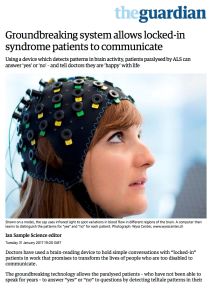Join getAbstract to access the summary!

Join getAbstract to access the summary!
Ian Sample
Groundbreaking System Allows Locked-In Syndrome Patients to Communicate
Using a device which detects patterns in brain activity, patients paralysed by ALS can answer ‘yes’ or ‘no’ – and tell doctors they are ‘happy’ with life
The Guardian, 2017
What's inside?
What if you were unable to communicate at all? Would life still be worth living?
Recommendation
Patients with completely locked-in syndrome (CLIS) can’t move any part of their bodies. Thus, they are unable to communicate. Caretakers, often family members, wonder what goes on in the minds of patients who haven’t communicated for many years. Now researchers have developed a novel brain-reading device that enables CLIS patients to respond to yes and no questions. The Guardian science editor Ian Sample reports about recent research, explains the underlying science and highlights CLIS patients’ somewhat unexpected responses when asked whether they were “happy” with life. getAbstract recommends this article to anyone who likes to challenge society’s definition of a happy life.
Summary
About the Author
Ian Sample is science editor of The Guardian and presents its Science Weekly podcast. Sample holds a PhD in biomedical material from Queen Mary’s, University of London.
















Comment on this summary